Ngaben Ceremony in Bali
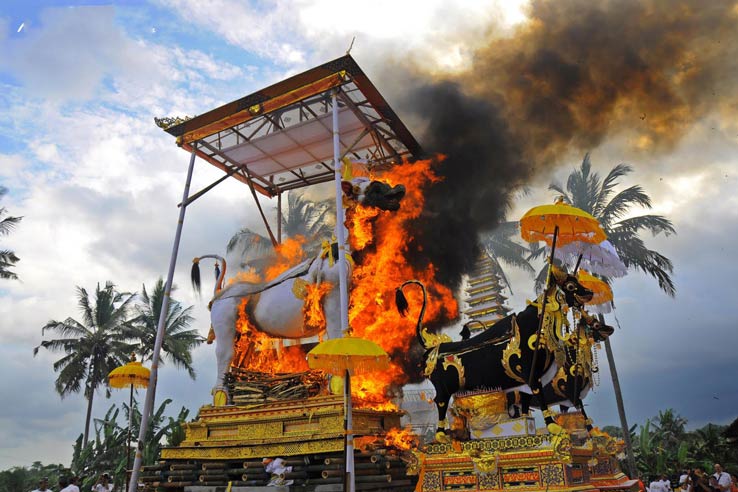
Ngaben Ceremony in Bali. Ngaben, also known as the Balinese cremation ceremony, is one of the most important and unique rituals in Balinese Hinduism. It is a symbolic and literal journey, where the soul of the deceased is returned to the cosmos to be reincarnated. The Ngaben ceremony is deeply embedded in Bali’s cultural and spiritual practices, showcasing the island’s intricate relationship with death, the afterlife, and the cycles of life and rebirth.
Balinese culture revolves around the concept of Tri Hita Karana, a belief in the harmonious relationship between humans, nature, and the divine. The Ngaben ceremony is a reflection of this philosophy, as it involves the cooperation of families, communities, and the divine realms to guide the soul on its journey to the afterlife. In this article, we will explore the rich cultural and spiritual significance of Ngaben, the various stages of the ceremony, and how it embodies the essence of Balinese culture.
1. Understanding Ngaben: The Purpose of the Cremation Ceremony
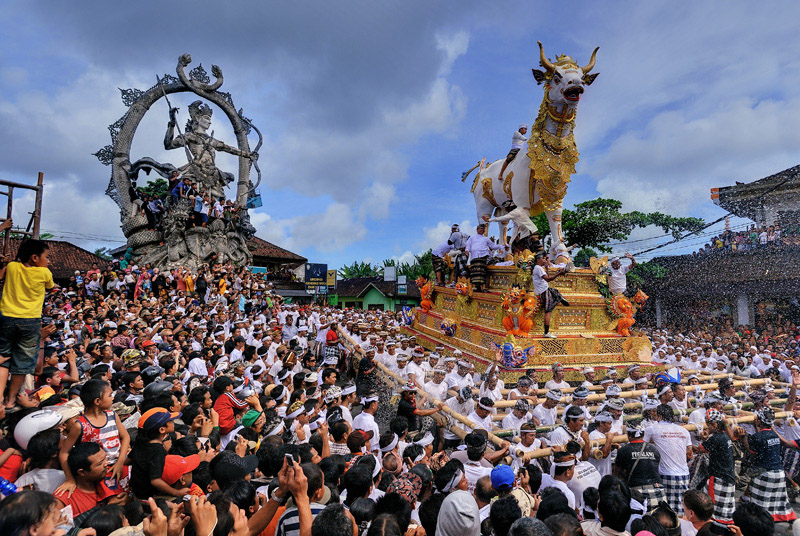
In Balinese Hinduism, death is not seen as an end but as a transition—a passage from one life to another. The Ngaben ceremony is essential for the deceased’s soul to be released from its physical body and begin the process of reincarnation. According to Balinese beliefs, the body is only a temporary vessel for the soul, and once a person dies, their spirit must be set free so it can move on to its next life.
The word “Ngaben” comes from the Balinese word “ngabu,” meaning to turn into ash. The central element of the Ngaben ceremony is the cremation of the deceased’s body, which symbolizes the release of the soul from its earthly form. By burning the body, the physical remains are returned to nature, while the soul is liberated and can continue its journey in the spiritual realm.
Ngaben is not only a personal event for the family of the deceased, but it is also a community affair. The ceremony is often a grand and elaborate occasion, involving the participation of extended family members, villagers, and local priests. It is seen as a celebration of life and a way to honor the deceased, rather than a time of mourning.
2. The Spiritual Significance of Ngaben
Ngaben is based on the Balinese Hindu belief in Samsara, the cycle of birth, life, death, and reincarnation. The ultimate goal of every Balinese Hindu is to achieve Moksha, or liberation from the cycle of rebirth, so that the soul can reunite with the divine. Ngaben is a crucial step in this process, as it helps the soul detach from the earthly plane and begin its journey toward Moksha.
During the Ngaben ceremony, it is believed that the soul of the deceased is transported to the afterlife by the gods, particularly Batara Siwa (Lord Shiva), who is responsible for dissolving the physical body and guiding the soul to its next destination. Without Ngaben, the soul may become trapped between worlds and unable to move on, which is why the ceremony is of such immense importance in Balinese culture.
The cremation ritual also reflects the Balinese concept of Rwa Bhineda, the belief in the balance of opposites. Just as life is balanced by death, creation is balanced by destruction, and birth is balanced by rebirth. Ngaben is a symbolic expression of this balance, as it honors both the ending of a life and the beginning of a new one.
3. Preparations for the Ngaben Ceremony
Ngaben is a highly elaborate and expensive ritual, often requiring months or even years of preparation. In many cases, families may delay the ceremony for several months or even years after a person’s death in order to gather enough resources or wait for an auspicious date determined by the Balinese calendar.
The preparations for Ngaben begin with the construction of an effigy or sarcophagus, which is designed to house the body of the deceased during the cremation. The effigy is often in the shape of an animal, such as a bull, lion, or dragon, which symbolizes different aspects of Balinese mythology and spirituality. The creation of the sarcophagus is an art form in itself, with intricate carvings and decorations that reflect the family’s devotion and respect for the deceased.
In addition to the sarcophagus, a cremation tower (known as a bade) is constructed. The bade is a tall, multi-tiered structure that is used to transport the body to the cremation site. The number of tiers in the bade is often determined by the deceased’s caste or social status, with higher tiers signifying greater honor and respect.
The entire village often participates in the preparation process, with community members helping to build the cremation tower, prepare offerings, and organize the various elements of the ceremony. The collaboration between family, friends, and neighbors reflects the strong sense of community in Balinese culture, where life and death are shared experiences.
4. Stages of the Ngaben Ceremony
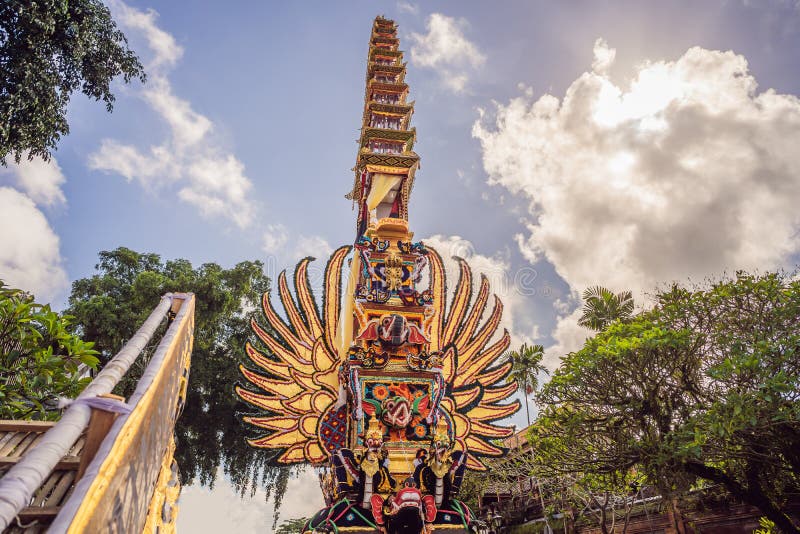
The Ngaben ceremony itself consists of several stages, each with its own spiritual and symbolic significance. While the specific rituals may vary from one village to another, the general structure of the ceremony is as follows:
a. Preparation of the Body
Before the cremation can take place, the body of the deceased is prepared and dressed in ceremonial attire. Family members bathe the body in a ritual cleansing, which symbolizes purification and preparation for the journey to the afterlife. The body is then wrapped in layers of white cloth and placed in the sarcophagus.
b. The Procession
One of the most dramatic and lively parts of the Ngaben ceremony is the procession from the family home to the cremation site. The cremation tower, which holds the body of the deceased, is carried through the streets by a group of men from the village. The procession is accompanied by music from a gamelan orchestra and prayers led by priests.
As the procession makes its way to the cremation site, it is often spun around at intersections and crossroads. This act is believed to confuse any evil spirits that might try to interfere with the journey of the soul. The spinning also symbolizes the separation of the soul from the physical world, helping it to let go of earthly attachments.
c. The Cremation
Once the procession reaches the cremation site, the sarcophagus and the body are placed on a large pyre. Before the cremation begins, offerings of flowers, food, and symbolic items are placed around the pyre to honor the deceased and invoke blessings from the gods.
The actual cremation is performed by a priest, who lights the pyre with sacred fire. As the body burns, the smoke is believed to carry the soul to the heavens, where it will be judged by the gods and prepared for reincarnation. Family members and friends gather around the pyre to offer prayers and witness the final moments of the ceremony.
d. Post-Cremation Rituals
After the cremation, the ashes of the deceased are collected and placed in an urn. These ashes are then taken to the sea, where they are scattered in a ritual known as Nganyut. This final act symbolizes the return of the body’s elements to nature and the release of the soul into the cosmos.
The family will continue to hold ceremonies and rituals in the weeks and months following the Ngaben, including memorials and prayers to ensure the soul’s safe passage through the afterlife and eventual reincarnation.
5. Variations of Ngaben: Pratiwa and Asti Wedana
While the standard Ngaben ceremony involves the immediate cremation of the body, there are other variations of the ritual, depending on the family’s circumstances and resources. One such variation is Pratiwa, where the body is buried for a certain period before being exhumed for cremation. This option is often chosen by families who need more time to gather the necessary resources for the ceremony.
Another variation is Asti Wedana, which is performed when only the bones of the deceased remain. In this case, the bones are exhumed from the burial site, cleansed, and then cremated in a similar ceremony to Ngaben.
6. Cultural and Spiritual Importance of Ngaben
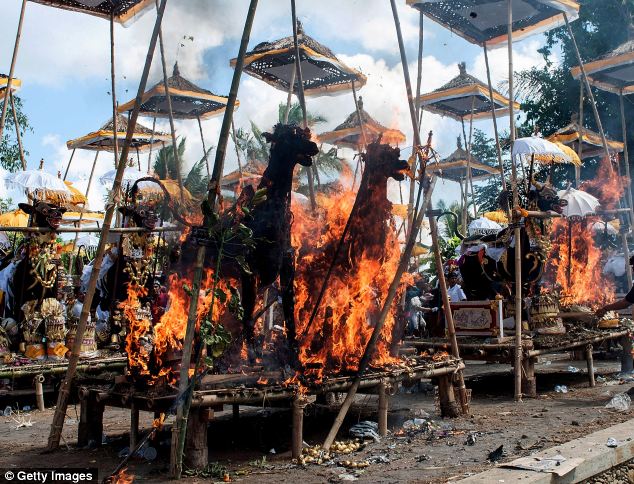
Ngaben is not just a funeral ceremony; it is a cultural celebration of life, death, and rebirth. It represents the Balinese belief in the cyclical nature of existence and the close relationship between the physical and spiritual worlds. For the Balinese, Ngaben is a joyous occasion, as it marks the successful transition of the soul to the afterlife, where it will be reunited with its ancestors and prepared for reincarnation.
The ceremony also reflects the Balinese emphasis on community and family, as it requires the participation of the entire village to ensure its success. Through the Ngaben, the Balinese people reaffirm their connection to their spiritual traditions, their ancestors, and the natural world.
7. Conclusion: Ngaben as a Reflection of Balinese Culture
Ngaben is a profound expression of Balinese spirituality and culture, embodying the island’s deep respect for life, death, and the afterlife. The ceremony’s elaborate rituals, vibrant processions, and symbolic acts all serve to honor the deceased and guide their soul on its journey through the cosmos. For those fortunate enough to witness a Ngaben ceremony, it is a deeply moving and enlightening experience, offering insight into the unique worldview of the Balinese people.
Ultimately, Ngaben is more than just a funeral—it is a celebration of the eternal cycle of life, death, and rebirth, and a testament to the enduring spiritual traditions of Bali.


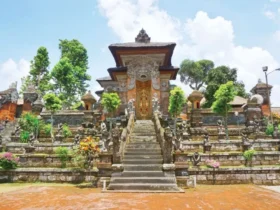



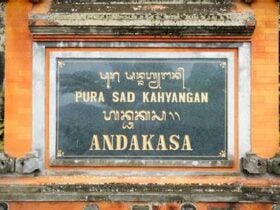
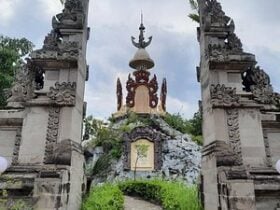

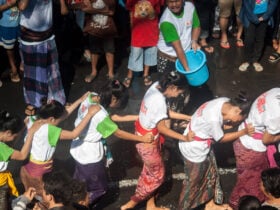
Leave a Review